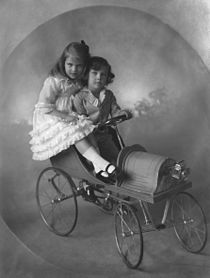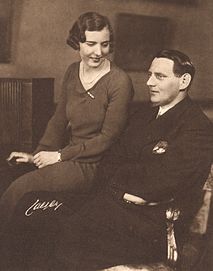Ingrid of Sweden
Ingrid of Sweden (full name: Ingrid Victoria Sofia Louise Margareta of Sweden ; born March 28, 1910 in Stockholm , † November 7, 2000 in Fredensborg Palace ) was the daughter of the Swedish King Gustav VI. Adolf and the British Princess Margaret of Connaught . In 1935 she married the future King of Denmark, Frederik IX. and was the Danish Queen by his side from 1947 to 1972.
childhood and education
Ingrid was born on March 28, 1910 in Stockholm Palace . Her father was Crown Prince Gustav Adolf of Sweden , eldest son of King Gustav V from his marriage to Princess Viktoria of Baden . Her mother Margaret of Connaught was a Princess of Great Britain and Ireland, granddaughter of Queen Victoria . On May 5, 1910 Ingrid was baptized in the castle church of Stockholm Castle. Her godparents were King Gustav V and Queen Victoria, the Queen Mother Sophia , Arthur, Duke of Connaught and Strathearn , Princess Luise Margareta of Prussia , Grand Duchess Luise of Baden , Princess Hilda of Nassau , Princess Therese of Saxe-Altenburg , Tsarina Alexandra Fjodorowna von Russia , Princess Alice, Countess of Athlone , Prince Adalbert of Prussia and King George V of Great Britain .
She spent her childhood and youth alternately in Stockholm Castle, Ulriksdal Castle and in the summer residence Sofiero Castle in southern Sweden. In 1919 she was one of the bridesmaids at the wedding of her aunt Patricia to Sir Alexander Ramsay. In May 1920, Ingrid's mother, who was very close to her, died as a result of blood poisoning , which she had contracted after an operation for an otitis media. In 1923 her father married Lady Louise Mountbatten , daughter of Prince Ludwig von Battenberg and Princess Victoria of Hesse-Darmstadt . Louise, who became Queen of Sweden at the side of Ingrid's father in 1950, could not make up for the loss. Her brother, the Swedish Hereditary Prince Gustav Adolf , was killed in the Kastrup plane crash in 1947 .
The princess was considered very conscientious and serious in her youth. Ingrid received extensive training in history, art history and political science and learned several languages. She was also interested in horse riding, skiing and tennis. Her knowledge of art and culture was deepened through longer stays in Paris and Rome . She also went on an extensive trip to the Orient early on.
Marriage and children
In the 1920s, there was much speculation about who Ingrid would marry. Her second cousin, who later became King Edward VIII , was a candidate for marriage. She met him in London in 1928, but nothing came of the meeting.
On March 15, 1935, a few days before her 25th birthday, she became engaged to Crown Prince Frederik of Denmark (1899–1972). He was the eldest son of King Christian X of Denmark and Queen Alexandrine . The couple married on May 24th of the same year in the Sankt Nikolai kyrka in Stockholm. The wedding was one of the biggest media events of the year. Among the wedding guests were the groom's parents, King Christian X. and Queen Alexandrine, King Leopold III. of Belgium and his wife Queen Astrid and the Crown Prince couple Olav and Märtha of Norway.
The newlyweds moved into the Brockdorff Palace, which is part of the Amalienborg Palace complex .
Ingrid and Frederik had three daughters together:
- Queen Margrethe II (born April 16, 1940), ⚭ Henri de Laborde de Monpezat
- Princess Benedkte (born April 29, 1944), ⚭ Richard zu Sayn-Wittgenstein-Berleburg
- Queen Anne-Marie (born August 30, 1946), ⚭ Constantine II of Greece
Importance in Denmark
After the wedding with the later Danish King Frederik IX. Ingrid aspired to become a distinctly Danish queen: she learned Danish perfectly and dealt intensively with the social conditions in Denmark . She developed a special love for the part of Sønderjylland , where Ingrid and Frederik ran the residence Gravenstein Castle from 1935 (Danish: Gråsten Slot ). As Queen from 1947 she took part in all of her husband's state visits as well as in the numerous trips to Greenland and the Faroe Islands . Ingrid managed to fulfill traditional representative duties and at the same time to appear as a modern woman. She advocated the female succession to the throne and prepared her daughter Margrethe for her future role as queen. The fact that so many Danes spoke out in favor of female succession in the 1953 referendum is also attributed to the fact that Ingrid played the role of queen at her husband's side with great charm and talent.
In addition to numerous social projects, she was very interested in art, culture and architecture. She helped to restore Fredensborg Castle to its original state during the renovation and to transform the parks of Fredensborg and Gravenstein into garden works of art.
During the time of the German occupation of Denmark , Ingrid encouraged her father-in-law, King Christian X , to continue his daily horse rides through Copenhagen , which became an important national symbol in the early years of the war. Another act of solidarity with the needy population was that Ingrid and her husband switched from the car to the bicycle during the war, which also underscored their modernity. The birth of their first child Margrethe in 1940 became another important symbol that established national identity during the dark war times.
After her husband's death in 1972, Ingrid lived for 28 years as a widow at Gravenstein Castle , at Brockdorff Palace at Amalienborg Palace in Copenhagen and at Fredensborg Palace . During this time, she still performed representative duties and, above all, continued her extensive involvement in social organizations.
When Queen Ingrid died on November 7, 2000 at Fredensborg Palace, her three daughters and ten grandchildren were gathered there. She was buried in the royal crypt in Roskilde Cathedral near Copenhagen.
ancestors
| Pedigree of Ingrid of Sweden | ||||||||
|---|---|---|---|---|---|---|---|---|
| Great-great-grandparents |
|
Duke |
Grand Duke |
Kaiser |
Duke Ernst I of Saxe-Coburg and Gotha |
Prince Edward Augustus, Duke of Kent and Strathearn |
Prince Carl of Prussia |
Duke Leopold IV of Anhalt-Dessau |
| Great grandparents |
|
Grand Duke |
Prince |
Prince |
||||
| Grandparents |
|
Prince |
||||||
| parents |
|
|||||||
|
Ingrid of Sweden |
||||||||
literature
- Grethe Jensen: Danmarks dronninger . In: Danske dronninger i tusind år . Edited by Steffen Heiberg. Gyldendal Verlag, Copenhagen 2000, pp. 98-100: INGRID
Web links
Individual evidence
- ↑ a b Queen Ingrid of Denmark. In: Telegraph.co.uk. Retrieved May 17, 2016 .
- ↑ a b c Grethe Jensen: Danmarks dronninger . In: Danske dronninger i tusind år . Edited by Steffen Heiberg. Gyldendal Verlag, Copenhagen 2000. ISBN 87-00-45504-0 . P. 98.
- ↑ Historical documents. In: Department of Foreign Affairs and Trade. Retrieved May 17, 2016 .
- ↑ a b Grethe Jensen: Danmarks dronninger . In: Danske dronninger i tusind år . Edited by Steffen Heiberg. Gyldendal Verlag, Copenhagen 2000. ISBN 87-00-45504-0 . P. 100.
- ↑ KVINFO, Danish biographical lexicon
- ^ Rheinische Post Online
| predecessor | Office | Successor |
|---|---|---|
| Alexandrine of Mecklenburg-Schwerin | Queen of Denmark 1947–1972 |
Margrethe II. |
| personal data | |
|---|---|
| SURNAME | Ingrid of Sweden |
| ALTERNATIVE NAMES | Ingrid Victoria Sofia Louise Margareta of Sweden |
| BRIEF DESCRIPTION | Danish co-regent of Swedish origin |
| DATE OF BIRTH | March 28, 1910 |
| PLACE OF BIRTH | Stockholm |
| DATE OF DEATH | November 7, 2000 |
| Place of death | Fredensborg Castle |




